Invention, Intellectual Property, and Income
Creating license
Intro.
So anything whatever you do will have purpose. Your invention will nourish you to survive and to growth in this society only if you take it ahead to a point where it start contributing in society by your hands.
Week Task:
develop a plan for dissemination of your final project
prepare drafts of your summary slide (presentation.png, 1920x1080)
and video clip (presentation.mp4, 1080p HTML5, < ~minute, < ~10 MB)
and put them in your root directory
I almost finished my project Grocubator and it turn to be attraction to people. Some people wanted to join me and take this project to product level and true is I too wanted to start generating Income from it.
I have no prior experience with business or incubating idea formally so I am confuse what to do and how to deal with it. I dont know what it will bring up in future for but I will keep exploring until I find out and make it worth.
Now moving to assignment I have no idea what to do so copied Pavan ji assigment because he is a MBA and have knowledge about legal things and business little more.
What is Invention?
Generally speaking, an invention is a new product or process that solves a technical problem. This is different from a discovery, which is something that already existed but had not been found.
An invention is a unique or novel device, method, composition or process. The invention process is a process within an overall engineering and product development process. It may be an improvement upon a machine or product or a new process for creating an object or a result. An invention that achieves a completely unique function or result may be a radical breakthrough. Such works are novel and not obvious to others skilled in the same field. An inventor may be taking a big step toward success or failure.Some inventions can be patented. The system of patents was established to encourage inventors by granting limited-term, limited monopoly on inventions determined to be sufficiently novel, non-obvious, and useful. A patent legally protects the intellectual property rights of the inventor and legally recognizes that a claimed invention is actually an invention. The rules and requirements for patenting an invention vary by country and the process of obtaining a patent is often expensive.(Wikipedia)
Type of Invention
Inventions are of three kinds: scientific-technological (including medicine), sociopolitical (including economics and law), and humanistic, or cultural.
Scientific-technological inventions include railroads, aviation, vaccination, hybridization, antibiotics, astronautics, holography, the atomic bomb, computing, the Internet, and the smartphone.
Sociopolitical inventions comprise new laws, institutions, and procedures that change modes of social behavior and establish new forms of human interaction and organization. Examples include the British Parliament, the US Constitution, the Manchester (UK) General Union of Trades, the Boy Scouts, the Red Cross, the Olympic Games, the United Nations, the European Union, and the Universal Declaration of Human Rights, as well as movements such as socialism, Zionism, suffragism, feminism, and animal-rights veganism.
Humanistic inventions encompass culture in its entirety and are as transformative and important as any in the sciences, although people tend to take them for granted. In the domain of linguistics, for example, many alphabets have been inventions, as are all neologisms (Shakespeare invented about 1,700 words).(Source-Wikipedia)
Intellectual Property
Intellectual property (IP) is a term referring to a brand, invention, design or other kind of creation, which a person or business has legal rights over. Almost all businesses own some form of IP, which could be a business asset.
Patent, copyright and trademark are all types of intellectual property rights that provide the creator an exclusive right over the use of his/her creation of mind for a limited amount of time. Entrepreneurs who are seeking to register intellectual property must know the differences between the three and obtain the right registrations to protect his/her intellectual property.
What is patent?
Patent is an exclusive right for an invention provided by the law for a limited time to the Patentee. By patenting an invention, the patentee is able to control the making, using, selling or importing of the patented product or process for producing that product without his/her consent. An invention relating either to a product or process that is new, involving inventive step and capable of industrial application can be patented in India.
What is Copyright?
Copyright is a right given by the law to creators of literary, dramatic, musical and artistic works and producers of cinematograph films and sound recordings. Copyright does not protect brands or names, short word combinations, slogans, short phrases, methods, plots or factual information. Copyright also does not protect ideas or concepts. Therefore, copyright is mainly used to protect the creativity of writers, artists, designers, dramatists, musicians, architects and producers of sound recordings, cinematograph films and computer software.
What is Trademark?
Trademark is a visual symbol which may be a word signature, name, device, label, numerals or combination of colours used by one Enterprise on goods or services or other articles of commerce to distinguish it from other similar goods or services originating from a different undertaking. Hence, trademarks are mostly used to protect brand names, business names, slogans and more.
Trade secrets
Trade secrets are a type of intellectual property that comprise formulas, practices, processes, designs, instruments, patterns, or compilations of information that have inherent economic value because they are not generally known or readily ascertainable by others, and which the owner takes reasonable measures to keep secret. In some jurisdictions, such secrets are referred to as confidential information.
Right of publicity
The right of publicity , sometimes referred to as personality rights, is the right of an individual to control the commercial use of one's identity, such as name, image, likeness, or other unequivocal identifiers. It is generally considered a property right as opposed to a personal right, and as such, the validity of the right of publicity can survive the death of the individual (to varying degrees depending on the jurisdiction).
DIFFERENT COPYRIGHT LICENSES
- Creative Commons (CC) license
- GNU General Public License
- BSD license
- MIT - Open Source license
- Apache License
 A Creative Commons (CC) license is one of several public copyright licenses that enable the free distribution of an otherwise copyrighted "work". A CC license is used when an author wants to give other people the right to share, use, and build upon a work that the author has created. CC provides an author flexibility (for example, they might choose to allow only non-commercial uses of a given work) and protects the people who use or redistribute an author's work from concerns of copyright infringement as long as they abide by the conditions that are specified in the license by which the author distributes the work.
A Creative Commons (CC) license is one of several public copyright licenses that enable the free distribution of an otherwise copyrighted "work". A CC license is used when an author wants to give other people the right to share, use, and build upon a work that the author has created. CC provides an author flexibility (for example, they might choose to allow only non-commercial uses of a given work) and protects the people who use or redistribute an author's work from concerns of copyright infringement as long as they abide by the conditions that are specified in the license by which the author distributes the work.
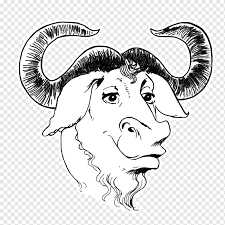 The GNU General Public License (GNU GPL or simply GPL) is a series of widely used free software licenses that guarantee end users the freedom to run, study, share, and modify the software. The licenses were originally written by Richard Stallman, founder of the Free Software Foundation (FSF), for the GNU Project, and grant the recipients of a computer program the rights of the Free Software Definition. The GPL series are all copyleft licenses, which means that any derivative work must be distributed under the same or equivalent license terms. This is in distinction to permissive software licenses, of which the BSD licenses and the MIT License are widely used, less restrictive examples. GPL was the first copyleft license for general use.
The GNU General Public License (GNU GPL or simply GPL) is a series of widely used free software licenses that guarantee end users the freedom to run, study, share, and modify the software. The licenses were originally written by Richard Stallman, founder of the Free Software Foundation (FSF), for the GNU Project, and grant the recipients of a computer program the rights of the Free Software Definition. The GPL series are all copyleft licenses, which means that any derivative work must be distributed under the same or equivalent license terms. This is in distinction to permissive software licenses, of which the BSD licenses and the MIT License are widely used, less restrictive examples. GPL was the first copyleft license for general use.
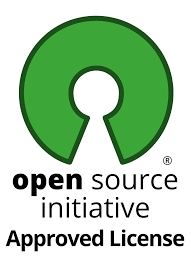 BSD licenses are a family of permissive free software licenses, imposing minimal restrictions on the use and distribution of covered software. This is in contrast to copyleft licenses, which have share-alike requirements. The original BSD license was used for its namesake, the Berkeley Software Distribution (BSD), a Unix-like operating system. The original version has since been revised, and its descendants are referred to as modified BSD licenses.BSD is both a license and a class of license (generally referred to as BSD-like). The modified BSD license (in wide use today) is very similar to the license originally used for the BSD version of Unix. The BSD license is a simple license that merely requires that all code retain the BSD license notice if redistributed in source code format, or reproduce the notice if redistributed in binary format. The BSD license (unlike some other licenses e.g. GPL) does not require that source code be distributed at all
BSD licenses are a family of permissive free software licenses, imposing minimal restrictions on the use and distribution of covered software. This is in contrast to copyleft licenses, which have share-alike requirements. The original BSD license was used for its namesake, the Berkeley Software Distribution (BSD), a Unix-like operating system. The original version has since been revised, and its descendants are referred to as modified BSD licenses.BSD is both a license and a class of license (generally referred to as BSD-like). The modified BSD license (in wide use today) is very similar to the license originally used for the BSD version of Unix. The BSD license is a simple license that merely requires that all code retain the BSD license notice if redistributed in source code format, or reproduce the notice if redistributed in binary format. The BSD license (unlike some other licenses e.g. GPL) does not require that source code be distributed at all
 The MIT license gives users express permission to reuse code for any purpose, sometimes even if code is part of proprietary software. As long as users include the original copy of the MIT license in their distribution, they can make any changes or modifications to the code to suit their own needs. It is one of the most simple open source license agreements. The intent was for the text to be understandable by average users and to avoid extensive litigation, which may arise from other similar Free and Open Source Software (FOSS) licenses.
The MIT license gives users express permission to reuse code for any purpose, sometimes even if code is part of proprietary software. As long as users include the original copy of the MIT license in their distribution, they can make any changes or modifications to the code to suit their own needs. It is one of the most simple open source license agreements. The intent was for the text to be understandable by average users and to avoid extensive litigation, which may arise from other similar Free and Open Source Software (FOSS) licenses.
 The Apache License is a permissive free software license written by the Apache Software Foundation (ASF).] It allows users to use the software for any purpose, to distribute it, to modify it, and to distribute modified versions of the software under the terms of the license, without concern for royalties. The ASF and its projects release their software products under the Apache License. The license is also used by many non-ASF projects.
The Apache License is a permissive free software license written by the Apache Software Foundation (ASF).] It allows users to use the software for any purpose, to distribute it, to modify it, and to distribute modified versions of the software under the terms of the license, without concern for royalties. The ASF and its projects release their software products under the Apache License. The license is also used by many non-ASF projects.
Creating license on Creative Common for Final project
Starting with going to creativecommons.org

Here you find option to share your work

After clicking on share your work page will open where you find Get started option. click it

It will move you to next step ask you to select license chooser here it showing beta version select it

Now easy part select option as shown in images and keep doing next. Here selecting the shown option will help you to find right license for you by just answering questions.
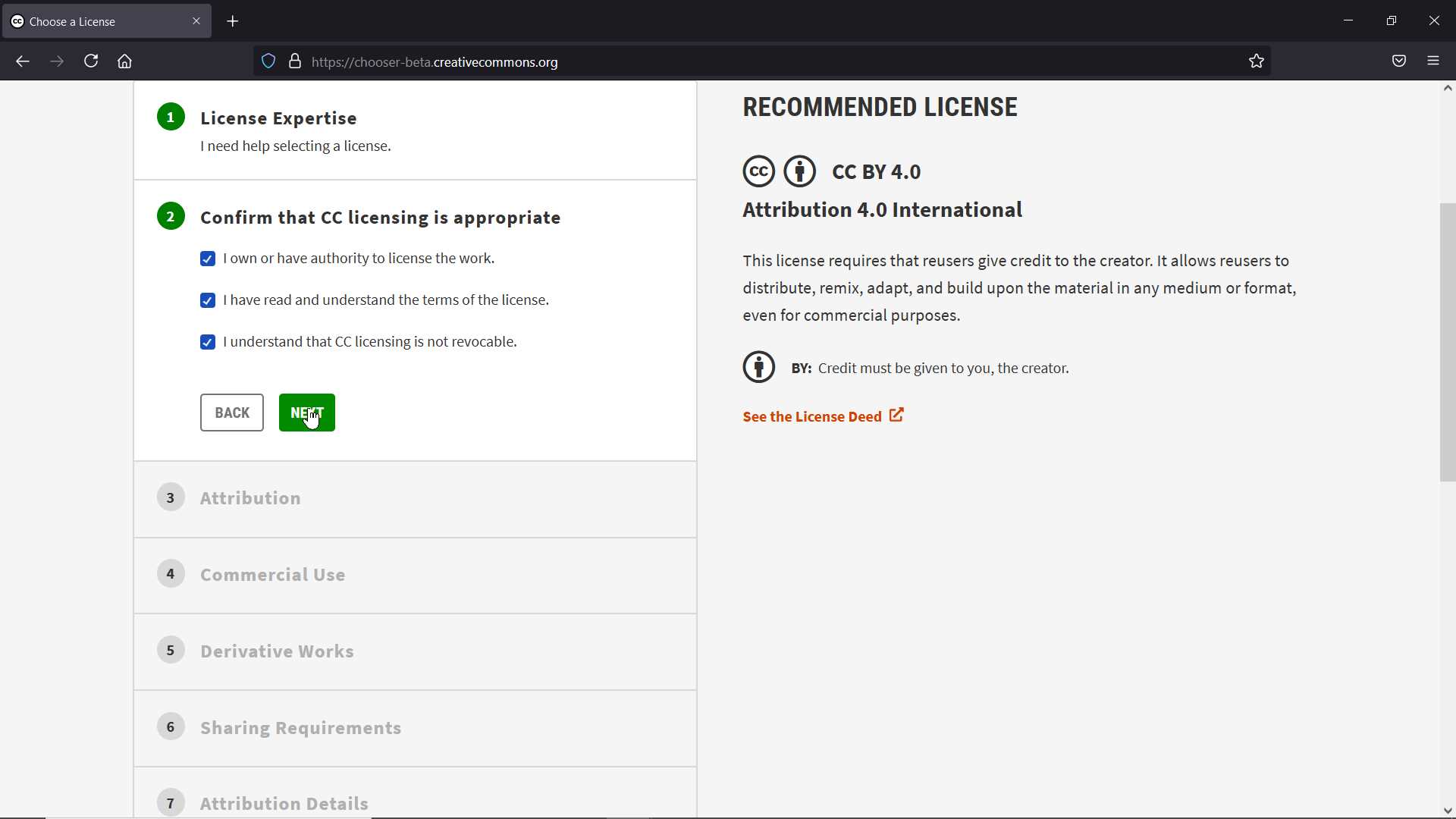
I confirm that this is my work by checking all option
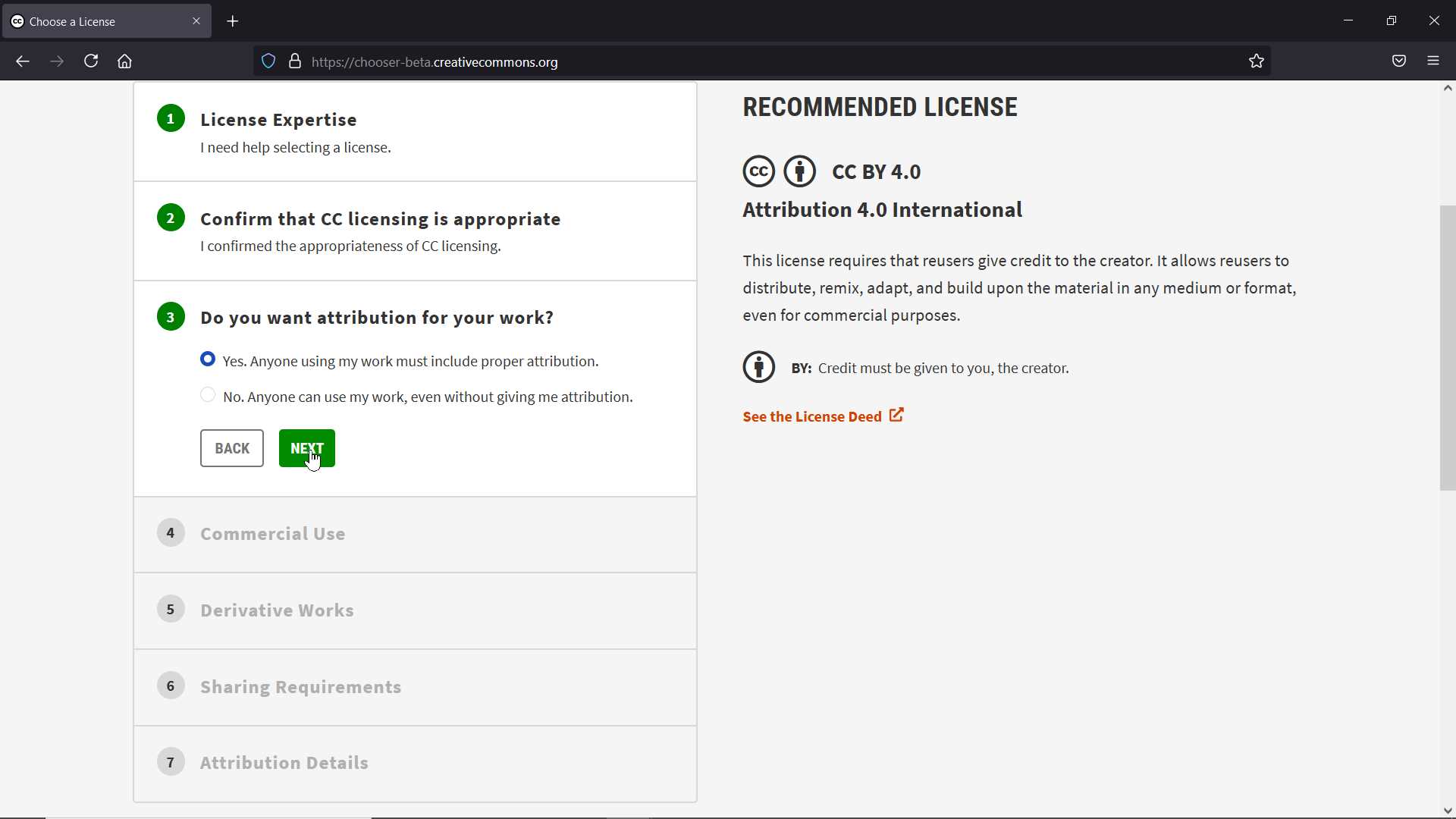
Here it ask that you wanted to allow it to be commercial by someone. I choose no but I am not that person who wanted to lock things but if someone really interest and wanted to work with it can inform me if I felt I will join him and that will help me also to generate income. or else I just ask for credit only.
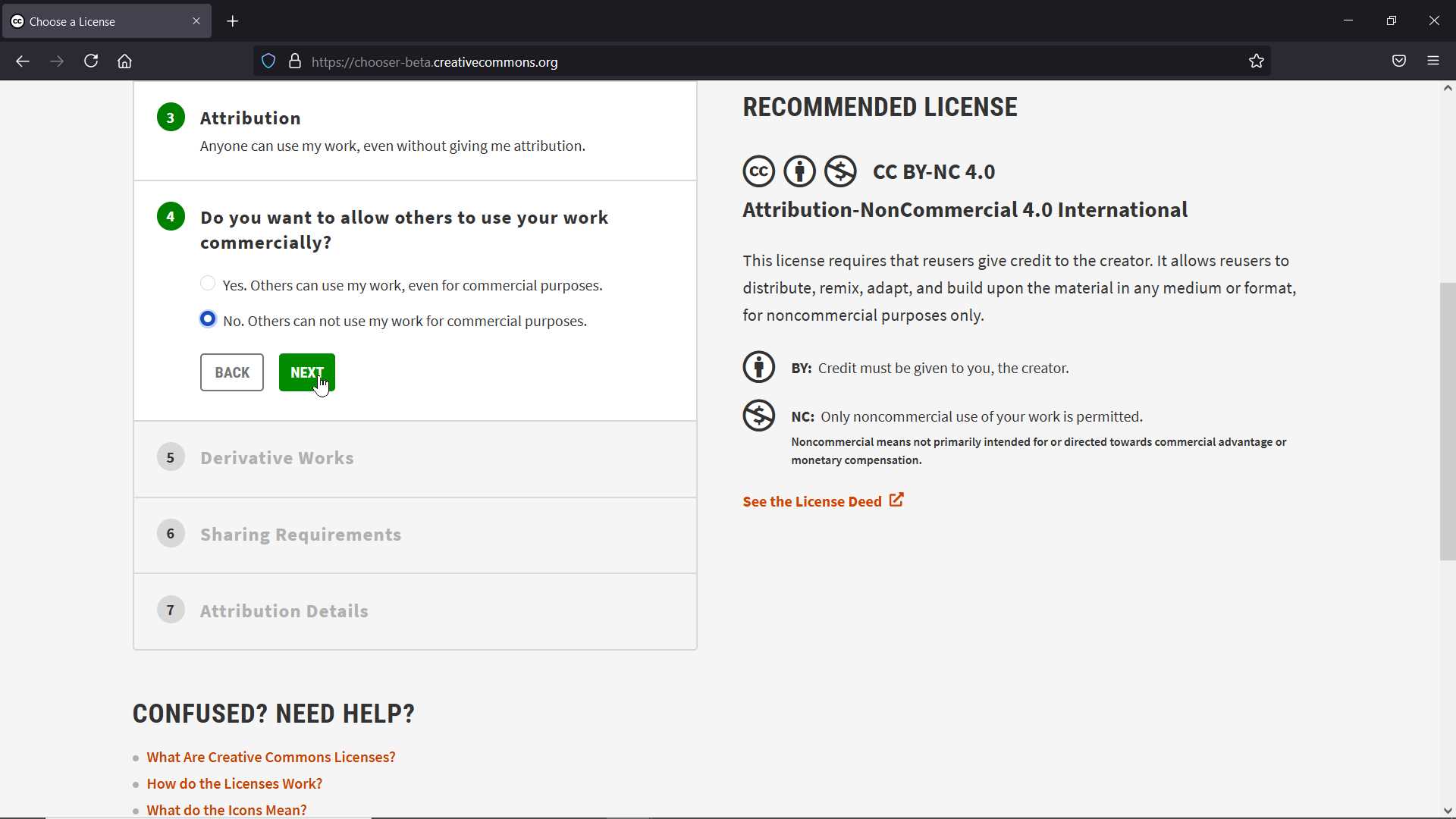
Ofcourse no This is my design my creativity my personality and I will not like some stranger change it without my consent.

Next Linking my content to generate license
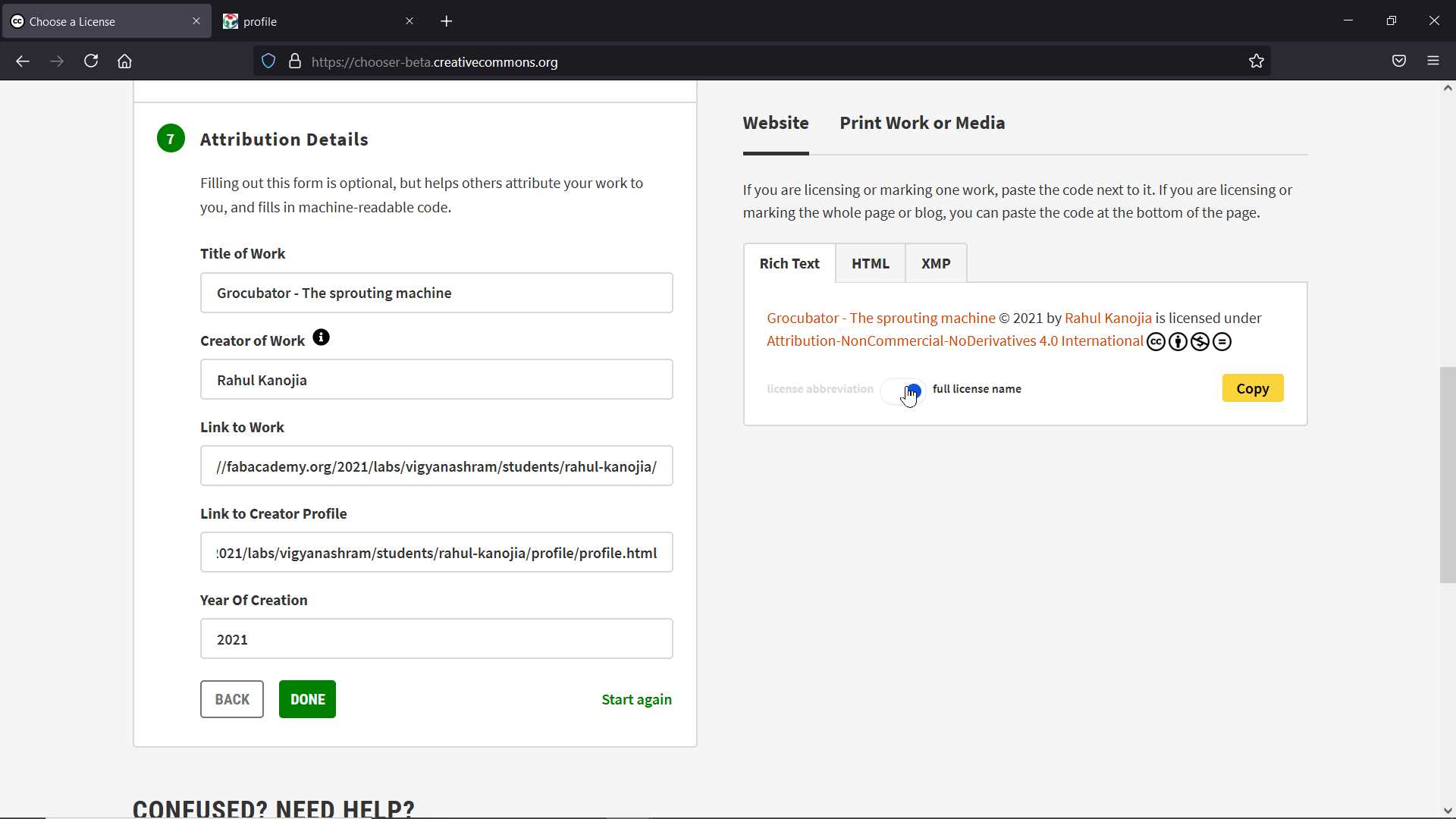
Now you got license in form of text, Html code etc to express people about your conditions on your creation. This license is to promote safe and healthy sharing culture
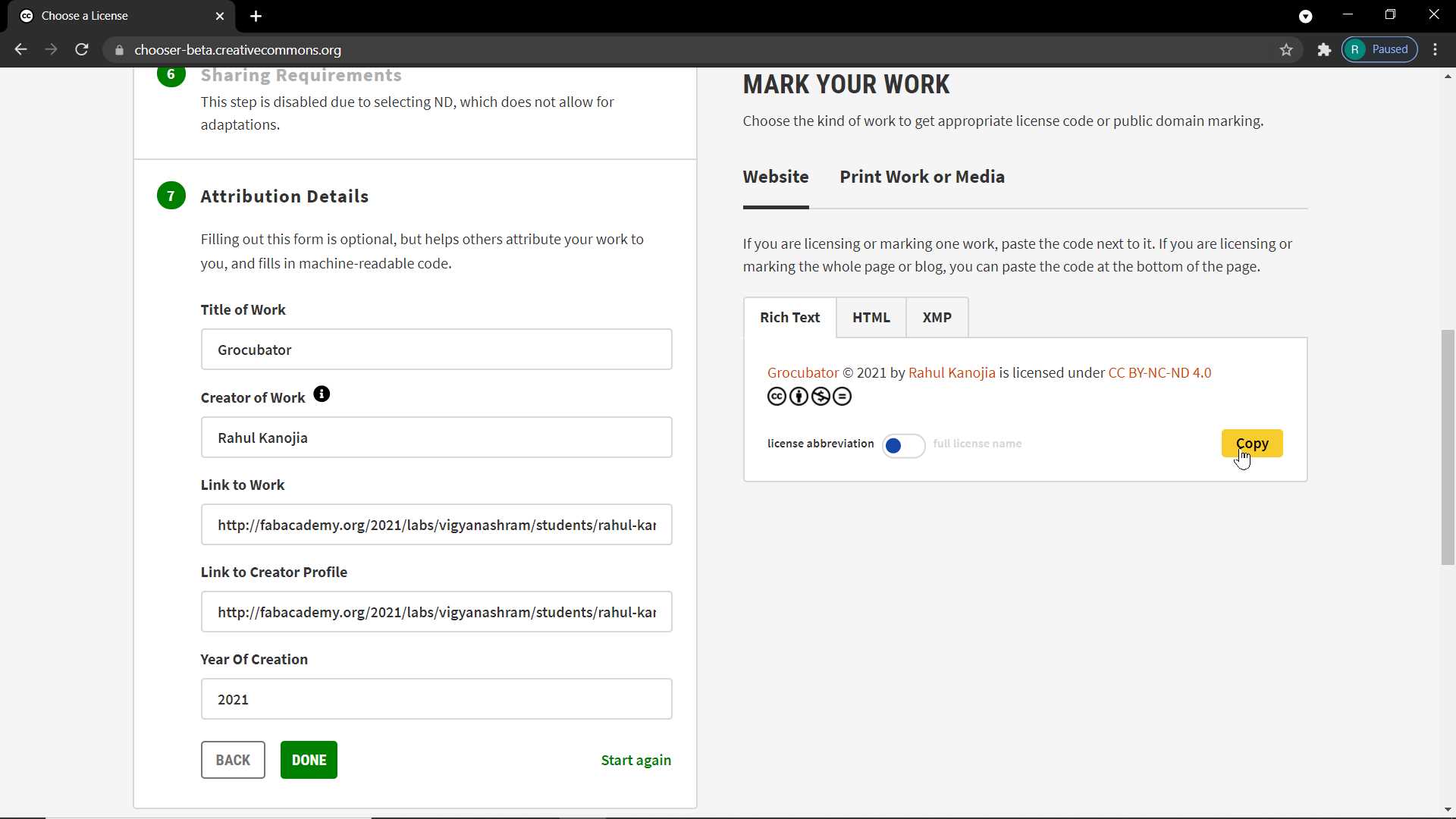
I copied Html code of a license and pasted it where people can easily see it like one on footer of my Homepage and one to my final project page. To show you how it look I will put it on this page to

as you see below this text. I pasted it on footer
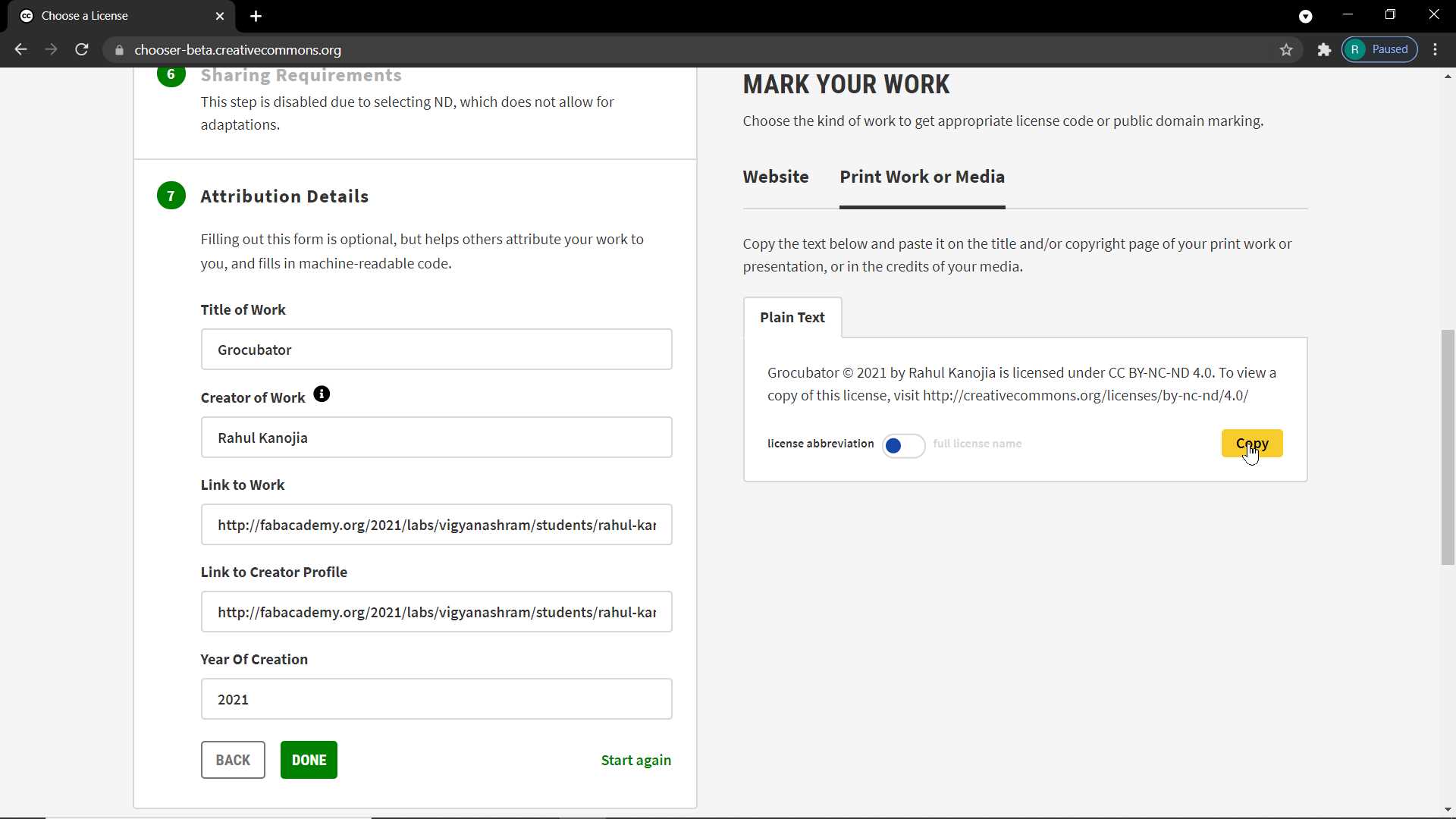
This text I copied and pasted on draft that tell about my project. So when people see they will know it and they will respect that

So I added my My Final presentation video in root directory and linked it on my final project page
Planning and Possibilities for future Development of Project:
Grocubator is unique machine that people will like to have in their Home. I am thinking to take it further and turn it to Home and Kitchen appliances product since this is prototype but actual product would not so different. It need some work with building material and more user friendly touch.
I am knee to do collaboration so if someone come to enjoy me and add his element to this idea I would love to work together.
Where you would Fabricate and Assemble your devices?
I have idea like this if now I have to start Fabrication I will reach to near fablab or people who have such setup or any institute. Like this one I made in vigyanashram and that is also good to go. Ofcourse I want my fablab but it will take time and resource so till I finish I will utilize external possibility.
How you would distribute the devices? (you directly, resellers, through internet, under the shape of a kit, etc)
I am not sure but In this begining time I would like to go with direct selling option to have customer relation more stronger, it will make data collection task easy and till here I able to provide other service to them. But Ofcourse to reach big market I prefer everything but since I have no idea how it will work so I keep it easy. I have to study to conclude anything.
Learning Outcomes:
Exploring all this content trigger my curiosity to learn about them more still for now I learn to make creative common license and by answering those question I got rain of ideas that I will experiment soon.